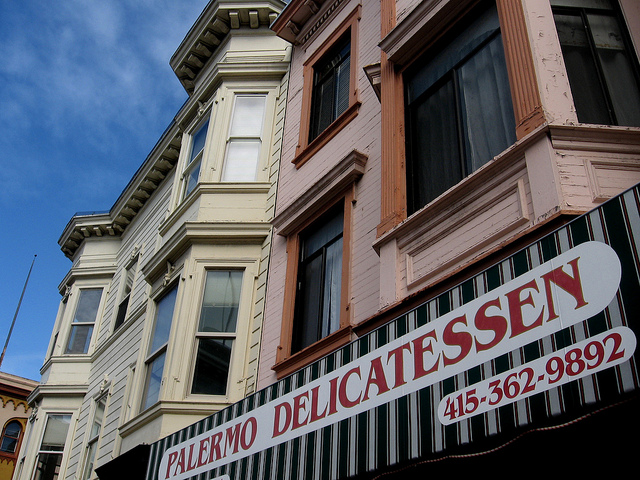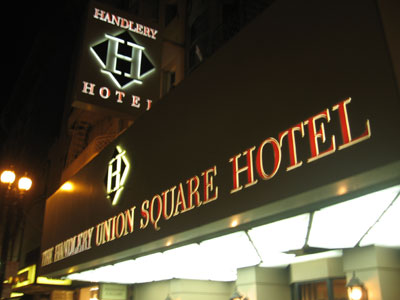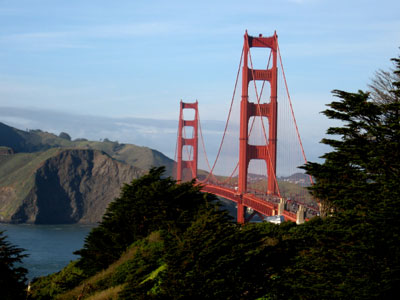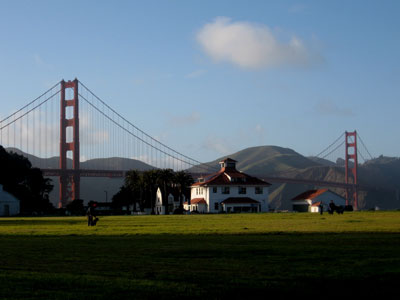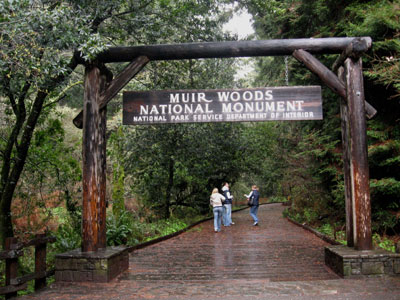After the rain and drizzle of our first day in San Francisco, day two of our adventure began more promisingly: bright sunshine greeted us as we made our way by public bus to Washington Square, the heart of San Francisco’s Italian-flavoured North Beach neighbourhood. We set off to meet Tom Medin, who runs Local Tastes of the City Tours, who was going to take us around this neighbourhood and introduce us to all sorts of interesting culinary treats.
As we started walking, Tom gave us a bit of an overview of San Francisco’s history – of its early beginnings in the 1770s when the Spanish established a small fort and a mission that was named after San Francis of Assisi. After Mexico broke away from Spain in 1821 California became part of Mexico and finally part of the United States in 1846. In 1849 finally things really started to take off with the Gold Rush, when San Francisco became the gateway to frontier opportunities for tens of thousands of prospectors in search of gold. The San Francisco’s 49ers football team is named after these heady days. Within one year, from 1848 to 1849, the population exploded from 1000 residents to 25,000!

Tom Medin, culinary expert, from Local Tastes of the City Tours
All sorts of entrepreneurs sought their fortune here, and one of the most successful was Levi Strauss who started to sell durable goods and heavy-duty canvas clothing to the miners. Other early San Francisco entrepreneurs include Domingo Ghirardelli who started to manufacture chocolate. Wells Fargo, another San Francisco venture, was founded in 1852. San Francisco’s first cable cars opened in 1873, and the city expanded greatly during the late 1800s as evidenced by the thousands of Victorian homes throughout the city. Ostentatious mansions owned by various wealthy business magnates were being built on Nob Hill in the second half of the 19th century.

Stunning arrchitecture
Another important milestone in San Francisco’s history was the devastating 1906 earthquake which led to fires that burned out of control for several days. Almost 500 people died and about 200,000 people (half the city’s population) became homeless. After rapid rebuilding the city flourished and San Francisco’s grand City Hall opened in 1915, the same year as the Panama-Pacific International Exhibition during which San Francisco celebrated its rebirth. The 1929 stock market crash started the Great Depression, a time during which San Francisco initiated two major civil engineering projects: the San Francisco-Oakland Bay Bridge and the Golden Gate Bridge, opened in 1936 and 1937 respectively.

The Trans-America Pyramid on a rainy day
During the Second World War San Francisco became an important embarkation point for the navy setting off into the Pacific Theater of Operations. In the 1950s and 1960s many west side neighbourhoods were demolished and numerous freeways were constructed. Authors of the Beat generation such as Jack Kerouac and Allen Ginsberg chose the North Beach neighbourhood in the 1950s as the hub of their creative endeavours. The city became famous across the world in the late 1960s when the hippie movement spread from the Haight-Ashbury neighbourhood, culminating in the 1967 Summer of Love. San Francisco was at the vanguard of the gay rights movement in the 1970s. San Francisco’s most well-known building, the Trans-America Pyramid, was opened in 1972.

Great views of San Francisco: The Coit Tower
In 1989 San Francisco got hit by another major disaster: the Loma Prieta earthquake destroyed many buildings in the Marina and South of Market districts and resulted in the demolition of the Embarcadero Freeway and much of the Central Freeway, giving the city a chance to reconnect with its historic downtown waterfront. The 1990s finally saw a great influx of dot.com and information technology companies which resulted in a huge increase in real estate price. Despite the 2001 bursting of the dot-com bubble, San Francisco remains a hotbed of high technology.

A North Beach landmark: Saints Peter and Paul Catholic Church
Against the historic backdrop of this vibrant city, we were going to explore one specific neighbourhood: North Beach, centered around Columbus and Broadway Avenues. The area indeed used to be a beach before San Francisco’s northern shoreline was filled in with soil a long time ago. Thousands of Italians settled here in the late 1800s and laid the foundation for this thriving neighbourhood full of cafés, delicatessens, restaurants and nightclubs.

One of the many inviting patios in North Beach
Tom, a passionate San Francisco resident, talked to us about the San Francisco lifestyle and informed us that walking is still very popular in this city, given its compact size and excellent public transit connections. People like to talk, connect, live a more well-balanced life-style. We also heard that San Francisco is a compassionate city, and that homelessness, one of the city’s most pervasive social problems, has been reduced by about 45% in recent years due to a combination of supportive housing, job counseling and mental health support programs.

Victorian row houses in North Beach
